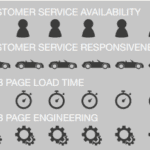Majestic Wine is using personal experience to inform the customer journey both online and offline, writes Chloe Rigby:
Putting the customer first doesn’t have to be glamorous or exciting, says Richard Weaver, ecommerce director at Majestic Wine. Rather there’s reassurance to be given by ensuring that customers get just what they expect when buying their wine online.
“We try very hard not to buck any trends,” says Weaver. “I think that is nowadays the single most important most important thing you can do for your customer is to make the website intuitive by just copying what everyone else does.” Rather, he says, it’s important to focus on the unglamorous basics, from page load time to website availability.
Customer service response
Majestic Wine, a Leading company in this Dimension, scores highly for its customer service response – yet its dedicated team consists of just three full-time employees and a social media manager. Online self-help is managed by the customer service team, with new questions added as new enquiries are repeated.
Many questions are handled at a local level, with stores using social media to engage with customers, while the digital team covers weekend customer service on a rota basis.
This helps to keep team members connected with what customers want, as does the fact that most head office staff, including the ecommerce team, have previously worked in stores and know what customers want from their many conversations with them.
Digital team members also learn from their own personal experience.
“We are all customers,” says Weaver, “and a lot of what we do that focuses on the customer is instinctive – it’s just what we do.”
He adds: “The style that we take, that human interaction, translates into what we do digitally. What we do well are the relatively low-tech things – it’s more about having an empathy for what customers want, and an understanding of what to do and not to do in order to keep your customers happy. You can spend a lot of time doing lots of research into what customers want, but in reality the best way to deliver it is just to put yourself in the shoes of the customer, and that really drives the approach that we take.” Important to that, he says, is deep product understanding that helps Majestic concentrate on wine-focused answers to questions.
Service as business development
This approach has over the years helped the retailer develop new and significant streams to the business. When Majestic Wine first set up its website, many customers wanted to order wine to send to a number of different destinations. Developers struggled with building a simple online system that could meet this complex demand, until one day a member of customer service staff simply started sending a spreadsheet to customers who wanted to make such orders – because that was simply much more straightforward and did not rely on an internet connection that might be disrupted. That approach is still used – and Majestic Wine’s multi-destination orders are today a multimillion-pound business.
While there might not ostensibly be much demand for a wine-based wedding list, that has nonetheless become an important area of the business after Majestic created the service for couples who either want to build a wine collection or want to enable guests to bring a bottle.
Getting personal
Relevant communications and service are now at the forefront of Majestic efforts, as it looks to develop individual relationships with its customers. Its recent acquisition of Naked Wines brings sophisticated customer insight systems to the business. “You can expect to see much more in the way of personalised and data-driven marketing coming from Majestic,” says Weaver. “But even then, we’ll put a human element on it.”
Recently the company has been developing a wine-recommendation engine based on the vintages that in-store employees recommend to customers in the store. Weaver: “It’s rooted in expertise rather than ‘customers who bought this also bought’. It’s much more about we really do believe if you like this wine, this is near enough that you should try it. It’s more about trying wine in a more structured way. Even where we’re personalising our marketing we’re still trying to make use of our human resources.”
This increasingly relevant engagement will be driven by what Weaver describes as a “single-ish” view of the customer, which marries up online and in-store purchases. A new myMajestic mobile app enables customers to see their purchasing history, whether they bought online or offline. The app has proved popular, giving the retailer the ability to understand how customers have bought in-store even when they don’t shop online.
Asked how others can best learn from the Majestic example, Weaver says having a good self-help system is important, as is a fast, helpful
and knowledgeable approach from customer service staff. But the most important thing, he says, is that they can help.
“The people who are dealing direct with customers, in delivering customer services, whether it be by telephone, email or on social media, need to be empowered and to know your business and your products in order to be able to help customers.”







